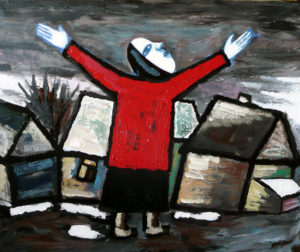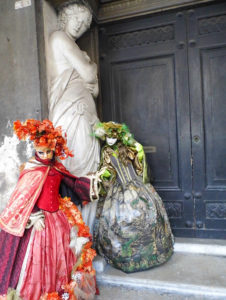Carnevale has been going on in Venice this year since the 8th of February, and soon we come to its conclusion, along with the conclusion of all the magnificent Carnival celebrations that have been happening in the lands where Carnival is celebrated, for Tuesday next brings Mardi Gras, Shrove Tuesday, Pancake Day. The day that follows will bring Ash Wednesday and the start of Lent.
In Venice and throughout Italy, the traditional symbol for Lent is a gaunt old woman, all skin and bones. She is known as La Vecchia: The Old One. Ah, but La Vecchia won’t show up until next Wednesday once her time of Quaresima begins. For now, it is Carnevale, a time to celebrate to excess. La Vecchia’s counterpart for Carnevale is a plump, jovial fellow wearing a garland of sausages around his neck. We are here to celebrate like there is no tomorrow. Out of that come the costumes and the wigs and the masks. In Venice, these tend to be beautiful and elaborate: exquisite costumes that harken back to the glorious Renaissance and Baroque ages of the city.
Here in the States, when we think of Mardi Gras, we think of New Orleans. But there are other convivial cities where the celebration is grand, too: Mobile and Key West come to mind. We have a burgeoning New Orleans style celebration happening in recent years in nearby Fort Lauderdale, too. But for the most part in this land first settled by English Puritans, we celebrate mainly with pancakes. And while it’s no Carnevale, still, pancakes for supper is not such a bad thing. It’s called Shrovetide in the English tradition––Shrove Tuesday being the British version of Mardi Gras. It’s also known as Pancake Day. We eat pancakes for supper that day because it is a meal that uses up the last of the eggs, milk, and sugar that remained in the larder before the forty fasting days of Lent commenced. Nowadays most of the fasting is done by folks who refrain from eating meat on Fridays. But in earlier times, the fast was more widely observed and much more strict. And so the intention was to refrain from all things of the flesh: meat, eggs, cheese, milk… sex, too, was out.
La Vecchia will be here before you know it, reminding us just how short our time on this earth is. So go ahead: enjoy these days. This is what Carnevale is all about.


